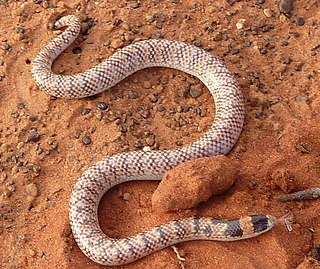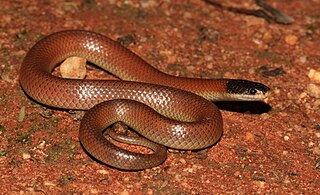
The eastern brown snake, often referred to as the common brown snake, is a species of highly venomous snake in the family Elapidae. The species is native to eastern and central Australia and southern New Guinea. It was first described by André Marie Constant Duméril, Gabriel Bibron, and Auguste Duméril in 1854. The adult eastern brown snake is up to 2 m (7 ft) long with a slender build. Its variable upper parts can be several shades of brown, ranging from pale brown to almost black, while its underside is pale cream-yellow, often with orange or grey splotches. The eastern brown snake is found in most habitats except dense forests. It has become more common in farmland and on the outskirts of urban areas, benefiting from agriculture due to the increased numbers of its main prey, the introduced house mouse. The species is oviparous. The snake is considered to be a least-concern species according to the International Union for Conservation of Nature (IUCN), though its status in New Guinea is unclear.

The dugite is a species of venomous, potentially lethal, snake native to Western Australia, a member of the family Elapidae.

Pseudonaja is a genus of venomous elapid snakes native to Australia. Species of this genus are known commonly as brown snakes and are considered to be some of the most dangerous snakes in the world; even young snakes are capable of delivering a fatal envenomation to a human.

The king brown snake is a species of highly venomous snake of the family Elapidae, native to northern, western, and Central Australia. Despite its common name, it is a member of the genus Pseudechis and only distantly related to true brown snakes. Its alternative common name is the mulga snake, although it lives in many habitats apart from mulga. First described by the English zoologist John Edward Gray in 1842, it is a robust snake up to 3.3 m (11 ft) long. It is variable in appearance, with individuals from northern Australia having tan upper-parts, while those from southern Australia are dark brown to blackish. Sometimes it is seen in a reddish-green texture. The dorsal scales are two-toned, sometimes giving the snake a patterned appearance. Its underside is cream or white, often with orange splotches. The species is oviparous. The snake is considered to be a least-concern species according to the International Union for Conservation of Nature (IUCN), though may have declined with the spread of the cane toad.
Paroplocephalus is a genus of venomous snake in the family Elapidae. The genus is monotypic, containing only the species Paroplocephalus atriceps, the Lake Cronin snake. The species is endemic to western Australia.

Brachyurophis is a genus of elapid snakes known as shovel-nosed snakes, so named because of their shovel-nosed snout which is used to burrow. The genus has eight recognized species, which are all found in Australia.

Dwyer's snake also known as the whip snake and the variable black-naped snake, is a species of venomous snake in the family Elapidae. The species is endemic to Australia, where it is found from New South Wales to South Queensland. While closely related to Australian sea snakes, P. dwyeri is a terrestrial reptile.
The blue-bellied black snake, also known commonly as the spotted black snake, is a species of venomous snake in the family Elapidae. The species is native to Australia.

Demansia is a genus of venomous snakes of the family Elapidae. Members of the genus are commonly known as whip snakes or whipsnakes, as are members of several other genera.

The curl snake is a species of venomous, heavily built snake in the family Elapidae. The species, which is native to Australia, is also known more commonly in Western Australia as the myall snake. The curl snake is often confused with a similar species named the Ord curl snake.
Ingram's brown snake is a species of venomous snake in the family Elapidae. The species is endemic to Australia.

The speckled brown snake or spotted brown snake is a species of venomous elapid snake native to northeastern Australia.
The monk snake, also known commonly as the hooded snake, is a species of venomous snake in the family Elapidae. The species is native to central and western Australia.

The Mallee black-backed snake, also known commonly as the black-backed snake, the copper snake, and Mitchell's short-tailed snake, is a species of venomous snake in the family Elapidae. The species is endemic to Australia.

The little whip snake, also known commonly as the whip hooded snake, is a species of venomous snake in the family Elapidae. The species is endemic to Australia.

The spectacled hooded snake, also known commonly as the Port Lincoln snake, is a species of venomous snake in the family Elapidae. The species is native to central-southern Australia. There are three recognized subspecies.
Gould's hooded snake, also known commonly as the black-headed snake, is a species of venomous snake in the family Elapidae. The species is endemic to Western Australia.
The Ord curl snake is a species of snake in the family Elapidae. It is endemic to Australia and native to the catchments of Ord and Victoria Rivers in the northern borderland region between Northern Territory and Western Australia. It occurs in tropical, seasonally dry woodlands and grasslands.
Brachyurophis incinctus is a species of snake from the family Elapidae, commonly named the unbanded shovel-nosed snake, and is a species endemic to Australia. Its common name reflects its shovel nose specialisation, burrowing behaviour and the fact that it is not banded on its body.












